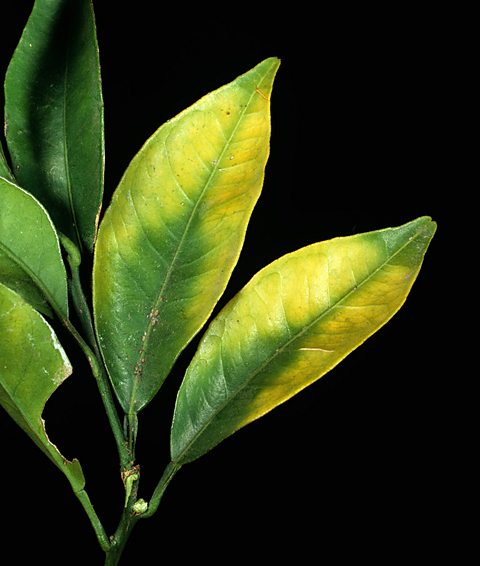Mineral ion deficiencies
deficiency diseaseA disease that develops because an organism (plant or animal) does not have enough vitamins or mineral ions. are diseases caused by a lack of essential vitamins or mineralsNaturally occurring, inorganic chemical substances. Minerals are necessary for both plant and animal health. ions. Scurvy is a deficiency disease historically found in sailors who did not have enough fresh fruit or vegetables, so were deficient in Vitamin C. Plants suffer from deficiency diseases when they do not have enough mineral ions.
Nitrate deficiency

Plants use nitrateThe chemical absorbed from the soil by plants to produce their protein. as a supply of nitrogen, which is needed to make proteins for healthy growth. Plants absorb nitrates in water through their roots. Nitrates are present in high levels in plant fertilisers.
Without nitrates, the amount of chlorophyllThe green chemical inside the chloroplasts of plant cells. It enables photosynthesis to take place. in leaves reduces. This means leaves turn a pale green or yellow colour. This reduces the plant's ability to photosynthesisA chemical process used by plants to make glucose and oxygen from carbon dioxide and water, using light energy. Oxygen is produced as a by-product of photosynthesis. Algae subsumed within plants and some bacteria are also photosynthetic. and grow properly, which reduces the farmers' yieldThe mass of a crop produced.. Farmers or gardeners can add chemical or natural fertilisers, such as manure to increase nitrate levels.
Magnesium ion deficiency
Plants use magnesium ions to make chlorophyll in their leaves. Like in nitrate deficiency, the plant is limited in terms of its photosynthetic ability and the plant growth is compromised. Magnesium is a limiting factorA factor which, if in short supply limits or reduces the rate of photosynthesis, eg temperature, light intensity and carbon dioxide concentration. in healthy plant growth.